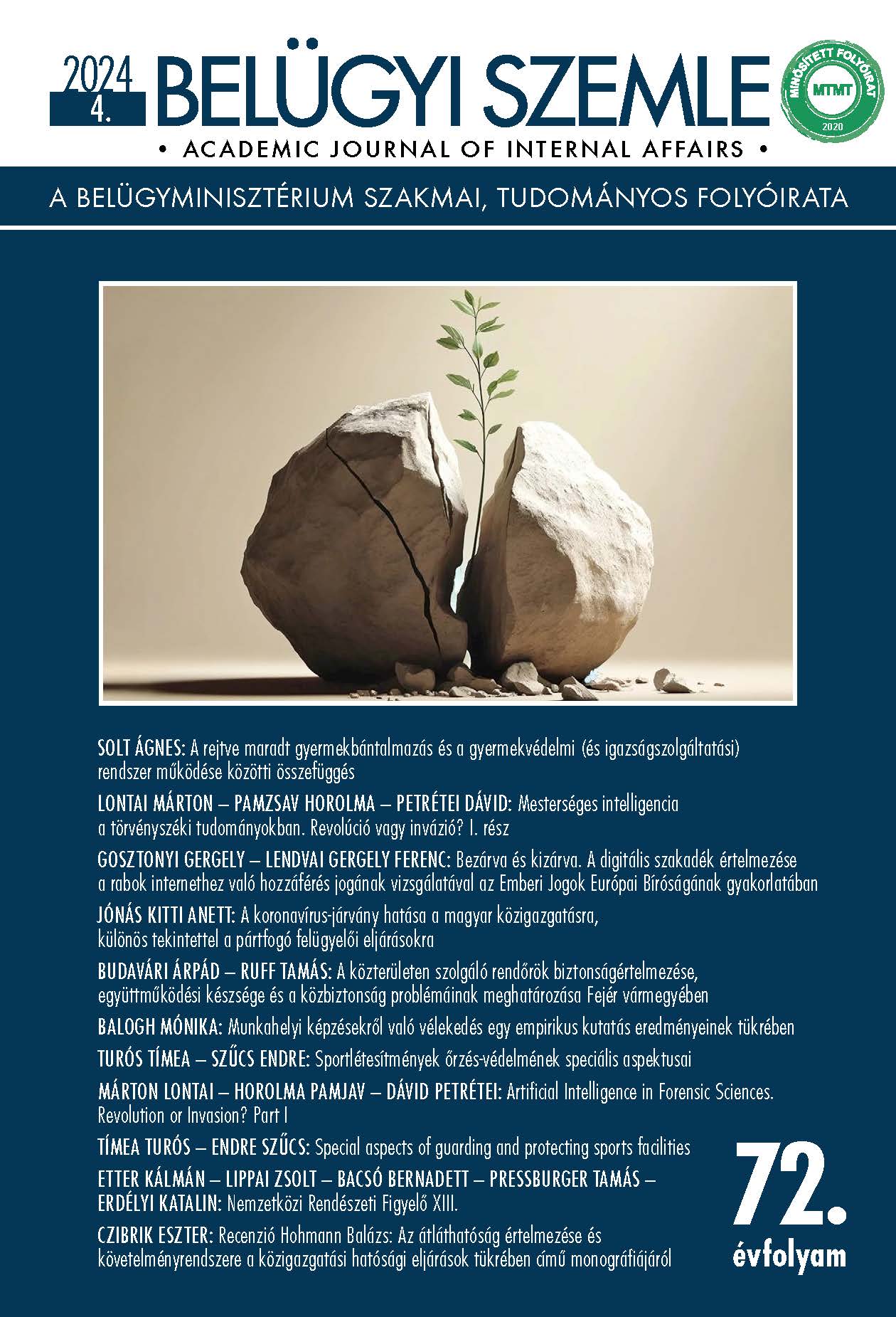Absztrakt
Aim: The first half of the two-part study is on the emerging role of artificial intelligence in the forensic sciences. After clarifying the basic concepts and a brief historical overview, the possibilities of using AI in various forensic fields are discussed: genetics, pattern recognition, chemistry, toxicology, anthropology, forensic medicine, and scene reconstruction.
Methodology: The study synthesises several recently published international papers.
Findings: The penetration of the application of artificial intelligence into some fields of science is undoubtedly an ongoing process. Most of the varied forensic fields also cannot avoid this development. Analysing large databases unmanageable with traditional methods, pattern recognition, and machine learning can all be important tools for forensic science. However, an important conclusion is that AI is a supporter of human expert work, not a substitute.
Value: In the field of forensic sciences, no such detailed summary article has been published in Hungarian so far.
Hivatkozások
Angyal, M. & Petrétei, D. (2019). A magyarországi áldozatazonosítási szolgálat felállításának kihívásai és tapasztalatai [Challenges and experiences in setting up a victim identification service in Hungary]. Nemzeti Közszolgálati Egyetem.
Bedeli, M., Geradts, Z. & van Eijk, E. (2018). Clothing identification via deep learning: forensic applications. Forensic Sciences Research, 3(3), 219–229. https://doi.org/10.1080/20961790.2018.1526251
Bewles, J., Low, A., Morphett, A., Pate, F. D. & Henneberg, M. (2019). Artificial intelligence for sex determination of skeletal remains: application of a deep learning artificial neural network to human skulls. Journal of Forensic and Legal Medicine, 62(1), 40–43. https://doi.org/10.1016/j.jflm.2019.01.004
Cantürk, İ. & Özyılmaz, L. (2018). A computational approach to estimate postmortem interval using opacity development of eye for human subjects. Computers in Biology and Medicine, 98(4), 93–99. https://doi.org/10.1016/j.compbiomed.2018.04.023
Chinnikatti, S. K. (2018). Artificial Intelligence in Forensic Science. Forensic Science & Addiction Research, 3(1). http://dx.doi.org/10.31031/FSAR.2018.03.000554
Dotzert, M. (2021). The Power of Algorithms in Analytical Chemistry. https://www.labmanager.com/insights/the-power-of-algorithms-in-analytical chemistry-23167
Galante, N., Cotroneo, R., Furci, D., Lodetti, G. & Casali, M. B. (2022). Applications of artificial intelligence in forensic sciences: Current potential benefits, limitations and perspectives. International journal of legal medicine, 137(2), 445–458. https://doi.org/10.1007/s00414-022-02928-5
Gasteiger, J. (2020). Chemistry in times of artificial intelligence. Chemphyschem: a European journal of chemical physics and physical chemistry, 21(20), 2233–2242. https://doi.org/10.1002/cphc.202000518
Hassan, M., Wanga, Y., Wang, D., Li, D., Liang, Y., Zhou, Y. & Xu, D. (2021). Deep learning analysis and age prediction from shoeprints. Forensic Science International, 327, 110987. http://dx.doi.org/10.1016/j.forsciint.2021.110987
Kamdar, S. R. & Pandey, A. (2011). The Scope of Artificial Intelligence in Forensic Science. The Indian Police Journal, 58(3), 48–51.
Mahasantipiya, P. M., Yeesarapat, U., Suriyadet, T., Sricharoen, J., Dumrongwanich, A. & Thaiupathump, T. (2011). Bite mark identification using neural networks: a preliminary study. Proceedings of the International MultiConference of Engineers and Computer Scientists, 1, 16–18.
Marciano, M. A. & Adelman, J. D. (2019). Developmental validation of PACE™: Automated artifact identification and contributor estimation for use with GlobalFiler™ and PowerPlex® fusion 6c generated data. Forensic Science International: Genetics, 43, 102140. https://doi.org/10.1016/j.fsigen.2019.102140
Mesejo, P., Martos, R., Ibáñez, Ó., Novo, J. & Ortega, M. (2020). A survey on artificial intelligence techniques for biomedical image analysis in skeleton-based forensic human identification. Applied Sciences, 10(14), 4703. https://doi.org/10.3390/app10144703
Moretti, T. R., Just, R. S., Kehl, S. C., Willis, L. E., Buckleton, J. S., Bright, J. A., Taylor, D. A. & Onorato, A. J. (2017). Internal validation of STRmix™ for the interpretation of single source and mixed DNA profiles. Forensic Science International: Genetics, 29, 126–144. https://doi.org/10.1016/j.fsigen.2017.04.004
Spivak, B. L. & Shepherd, S. M. (2021). Ethics, artificial intelligence, and risk assessment. The journal of the American Academy of Psychiatry and the Law, 49(3), 335–337. https://doi.org/10.29158/JAAPL.210066-21
Szabó, B. T. (2019). A CBCT képalkotó megbízhatóságának vizsgálatai [Tests of the imaging reliability of CBCT]. Doctoral dissertation. Semmelweis Egyetem Klinikai Orvostudományok Doktori Iskola.
Taylor, D., Harrison, A. & Powers, D. (2016). An artificial neural network system to identify alleles in reference electropherograms. Forensic Science International: Genetics, 30, 114–126. https://doi.org/10.1016/j.fsigen.2017.07.002
Taylor, D., Harrison, A. & Powers, D. (2019). The generalisability of artificial neural networks used to classify electrophoretic data produced under different conditions. Forensic Science International: Genetics, 38, 181–184. https://doi.org/10.1016/j.fsigen.2018.10.019
Thurzo, A., Kosnáčová, H. S., Kurilová, V., Kosmel, S., Beňuš, R., Moravanský, N., Kováč, P., Kuracinová, K. M., Palkovič, M. & Varga, I. (2021). Use of Advanced Artificial Intelligence in Forensic Medicine, Forensic Anthropology and Clinical Anatomy. Healthcare, 9(11), 1545. https://doi.org/10.3390/healthcare9111545
Zhou, Z. & Zare, R. N. (2017). Personal information from latent fingerprints using desorption electrospray ionization mass spectrometry and machine learning. Analitical Chemistry, 89(2), 1369–1372.

This work is licensed under a Creative Commons Attribution-NonCommercial-NoDerivatives 4.0 International License.
Copyright (c) 2024 Belügyi Szemle

